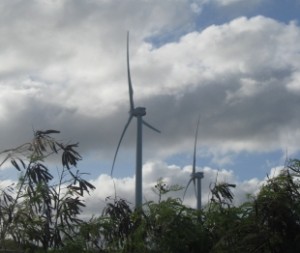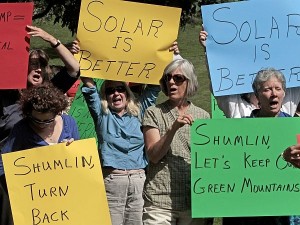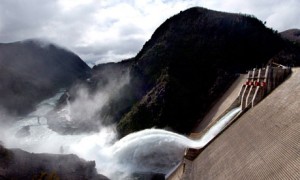Micro Hydro Power in Indonesia
Winners of an Ashden International Award in 2012, IBEKA has developed off-grid hydro schemes to bring the benefits of electricity – like good quality light, TV and power tools – to remote communities
BP And Sempra U.S. Gas & Power Announce Plans To Jointly Develop Hawaii Wind Farm
 Sempra U.S. Gas & Power and BP Wind Energy today announced plans to jointly develop the Auwahi Wind farm in Hawaii. This is the fifth project developed under a strategic partnership between the two companies that includes more than 1,000 megawatts (MW) of wind generating capacity in operation or under construction.
Sempra U.S. Gas & Power and BP Wind Energy today announced plans to jointly develop the Auwahi Wind farm in Hawaii. This is the fifth project developed under a strategic partnership between the two companies that includes more than 1,000 megawatts (MW) of wind generating capacity in operation or under construction.
Located in southeastern Maui, the 21-MW wind farm will utilize eight Siemens wind turbines to generate enough renewable power for approximately 10,000 average Maui homes. Initial construction activities are underway and full mobilization at the site is slated to begin by the end of the second quarter 2012. The project will employ about 150 workers during the peak of construction and is expected to be in commercial operation by year-end 2012. The balance of plant contract has been awarded to RMT WindConnect.
Sempra U.S. Gas & Power will continue leading the development of Auwahi Wind and operate the project once construction is complete.
“We are pleased to have the opportunity to further expand our highly successful strategic partnership with BP Wind Energy while helping Hawaii advance one step closer to its renewable energy goals,” said Jim Sahagian, vice president of renewables for Sempra U.S. Gas & Power. “Our companies share a commitment to building and operating the Auwahi Wind farm in a way that reflects Maui’s commitment to environmental protection. We look forward to providing a stable supply of clean power to the region and becoming a long-term partner with the local community.”
“BP is once again proud to partner with Sempra U.S. Gas & Power to grow our investment in the renewable power sector to produce essential sources of cost-competitive energy to our customers,” said John Graham, president and CEO, BP Wind Energy. “Today marks an important milestone as this is BP’s first venture in delivering clean energy to the people of Hawaii.”
The entire power output from the wind farm has been sold under a long-term power purchase agreement to the Maui Electric Company. This new source of locally-produced wind power helps Hawaii reach its clean energy goal to secure 40 percent of its electricity from renewable sources by 2030.
In a first for the BP and Sempra U.S. Gas & Power strategic partnership, the Auwahi Wind farm will utilize a battery storage unit capable of storing in excess of 4 megawatt hours of renewable power. This stored electricity will help to regulate the intermittent wind power, providing a valuable source of grid stability for Maui Electric Company.
In January 2012, BP and Sempra U.S. Gas & Power announced an expansion of their strategic relationship by jointly investing more than $1 billion to build 560 MW of wind power. In Kansas, the companies are building the 419 MW Flat Ridge 2 Wind Farm and are finalizing joint venture agreements for a 51 MW expansion project. In Pennsylvania, the 141 MW Mehoopany Wind Farm is in construction. Both the Kansas and Pennsylvania wind farms are expected to be in commercial operation by year-end 2012 and will be the largest wind projects ever constructed in their respective states. The companies are also equal partners on the 200 MW Fowler Ridge 2 Wind Farm in Indiana and the 250 MW Cedar Creek 2 Wind Farm located in northeastern Colorado.
A Leader In Wind Power
“Denmark is the leading wind power nation in the world, an unrivalled hub of knowledge, expertise and advanced technology. More than 20% of the Danish electricity consumption is covered by clean energy from wind turbines.”
US House Passes Hydropower Development and Rural Jobs Act
 Legislation introduced by Rep. Scott Tipton (CO-R) and Rep. Paul Gosar (AZ-R) – the Bureau of Reclamation Small Conduit Hydropower Development and Rural Jobs Act of 2012 (H.R. 2842), passed the U.S. House of Representatives by a bipartisan vote of 265-154. The bill will spur rural economic development and increase production of clean, renewable hydropower by removing bureaucratic over regulation.
Legislation introduced by Rep. Scott Tipton (CO-R) and Rep. Paul Gosar (AZ-R) – the Bureau of Reclamation Small Conduit Hydropower Development and Rural Jobs Act of 2012 (H.R. 2842), passed the U.S. House of Representatives by a bipartisan vote of 265-154. The bill will spur rural economic development and increase production of clean, renewable hydropower by removing bureaucratic over regulation.
“Residents of Arizona are looking for solutions to two of the biggest problems facing them now: the need for jobs and the need for additional energy sources,” said Congressman Paul Gosar (R-AZ). “Energy providers in areas like Pinal and Yuma County, Arizona are waiting on Congress to act so they can tap our state’s goldmine of hydropower potential. This common sense legislation will create jobs and increase our country’s renewable energy portfolio by cutting duplicative, bureaucratic red tape. There is not one solution to our nation’s energy crisis, but increased hydropower is vital part of our all-of-the-above strategy.”
The Beardsley Canal: a conduit managed by the Maricopa Water District in western AZ that has a high potential for a hydropower project. The Bureau of Reclamation Small Conduit Hydropower Development and Rural Jobs Act of 2012 will allow American energy producers to install small-scale hydropower generators on existing, man-made pipelines and canals. This red tape is unnecessary because environmental reviews have already been conducted on these man-made facilities, and they do not contain endangered fish and wildlife. In some cases, this duplicative red tape doubles the cost of the hydropower facility, making development cost-prohibitive.
Yesterday, Congressman Gosar spoke on the House floor in support of this bill. To hear the full speech please see the video or read the full-text here. H.R. 2842 is supported by the Family Farm Alliance, the American Public Power Association, the National Water Resources Association, Irrigation & Electrical Districts Association of Arizona, and the Association of California Water Association.
Revolutionary New Fish Friendly Hydropower
 A revolutionary new turbine technology for hydropower plants is one step closer to its first commercial deployment. The Alden Fish-Friendly Turbine could change the game for hydropower generation in the United States, and it is likely to have significant export potential.
A revolutionary new turbine technology for hydropower plants is one step closer to its first commercial deployment. The Alden Fish-Friendly Turbine could change the game for hydropower generation in the United States, and it is likely to have significant export potential.
Scientists and engineers at the Electric Power Research Institute (EPRI), Alden Laboratories, and their partners have designed a new turbine that reduces fish passage injury and mortality, while effectively maintainingpower production. EPRI recently released the full technical report of prototype testing. Building on over a decade of support from the Energy Department, EPRI and its project partners were recently selected to deploy and test the Alden fish-friendly hydropower turbine over the next three years. EPRI plans to deploy the 10 megawatt Alden Turbine at the Brookfield Renewable Power School Street Project in Cohoes, New York, bringing project’s generation capacity to 48 megawatts.
Hydropower already provides nearly 7 percent of the nation’s electricity, and it holds tremendous potential for expansion. Yet that promise comes with the unique challenge of developing water as a renewable energy resource in a way that minimizes disruption to sensitive ecosystems and mitigates impacts to fish and other aquatic wildlife. Some hydropower projects have created issues for migratory fish, such as blocked passages and turbine-induced mortality. Spilling water or installing bypass technologies can allow fish to pass through unharmed, but they also compromise a significant amount of power production—to the tune of 8,500 MWh per year and at a cost upwards of $700,000 per project. Read the full article:Revolutionary New Fish Friendly Hydropower
Oregon proposes approval of Ocean Power Technologies’ wave energy project off Reedsport
 By Scott Learn, The Oregonian: Oregon environmental regulators today proposed approving a New Jersey company’s plan to put 10 wave energy buoys off the central Oregon coast .
By Scott Learn, The Oregonian: Oregon environmental regulators today proposed approving a New Jersey company’s plan to put 10 wave energy buoys off the central Oregon coast .
The Department of Environmental Quality has concluded that Ocean Power Technologies’ project near Reedsport and Gardiner will comply with Oregon’s water quality standards and not harm ocean life.
Ocean Power Technologies wants to deploy its first wave energy test buoy 2 1/2 miles off the coast by mid-2012.
The company expects to follow that buoy with nine others, eventually creating the country’s first commercial wave energy park.
The project would cover 30 acres with a maximum output of 1.5 megawatts, enough to power about 1,500 homes.
DEQ’s proposed water quality certification for Reedsport OPT Wave Park, LLC, would require the company to monitor water quality and environmental effects to verify compliance.
For example, the company must monitor for turbidity — muddy water — during installation of wave energy converters and a 2.8-mile buried transmission cable.
Other DEQ concerns include electromagnetic fields that could disrupt whale migrations or disorient salmon, and shoreline erosion if the buoys alter ocean currents.
The initial buoy is being built in Clackamas at Oregon Iron Works, with additional work by Vigor Industrial in Portland and an American Bridge Manufacturing plant in Reedsport. The buoy is about a 140 feet long and 40 feet wide, with a 30-foot float rising out of the water.
Critics, including some crabbers and fishermen, worry that the project, with 12 miles of mooring line, could interfering with fishing and potentially harm ocean life.
The company is also seeking approvals from the U.S. Army Corps of Engineers and the Federal Energy Regulatory Commission. Both agencies require DEQ approval before the project can go forward.
DEQ is accepting comments on its draft water quality certifications through Nov. 14. It will hold a public hearing on the project Oct. 25 at Reedsport City Hall.
Protesters Call For More Solar, Fewer Wind Projects
 Protesters turned out on the Statehouse lawn on Wednesday to oppose a wind energy project in Lowell and others planned around the state. The critics of large-scale wind say solar power is the better way to meet Vermont’s energy needs.
Protesters turned out on the Statehouse lawn on Wednesday to oppose a wind energy project in Lowell and others planned around the state. The critics of large-scale wind say solar power is the better way to meet Vermont’s energy needs.
VPR’s John Dillon reports: Listen Here
(Host) Protesters turned out on the Statehouse lawn on Wednesday to oppose a wind energy project in Lowell and others planned around the state.
The critics of large-scale wind say solar power is the better way to meet Vermont’s energy needs.
VPR’s John Dillon reports:
(Dillon) They came by bus, many from the Northeast Kingdom, the region of the state that’s now in the bull’s eye of ridgeline wind development.
Luke Snelling is with Energize Vermont, a group that opposes the projects. He told the crowd that solar energy is getting cheaper and is the better, less environmentally damaging alternative.
(Snelling) “We’re here fighting for our energy liberation. We can no longer expect that corporations in this state will set the tone for our energy future. We can’t allow it. So we’re here today to say to say no more! No more to GMP setting the agenda!” Crowd cheers.
(Dillon) Green Mountain Power is the developer of a 21 turbine project planned for the Lowell Mountain ridgeline.
The project would be the largest wind development in the state, and it’s won almost all the permits it needs from state regulators.
But the protesters want Governor Peter Shumlin to drop his support for large-scale wind. Organizer Steve Wright from Craftsbury delivered a letter to Shumlin’s office. He says a four-mile long road planned for the Lowell ridgeline will be 405 feet wide at each of the 21 turbine sites.
(Wright) “That’s a crime against the landscape of Vermont. We don’t need to do it, we’re smarter than that. Vermonters know how to stay warm without burning the furniture in their own house.”
(Dillon) Wright is a former state commissioner of fish and wildlife who says the large wind projects damage wildlife habitat and harm upland streams.
GMP says it’s planned the project to minimize the impact on the environment. Dorothy Schnure is the company spokeswoman.
(Schnure) “Any major project in Vermont is going to have a variety of opinion, and a difference of opinion. But what we do know is that most people in Vermont support the development of wind power. And we know that people in Lowell, we know that members of Vermont Electric Co-op, have supported this project.”
(Dillon) The protesters were not just focused on Lowell. Ira Powsner is community organizer with Energize Vermont. He says about 10 projects are planned statewide. Powsner says towns can protect their ridgelines through strong zoning ordinances and town plans.
(Pownser) “That’s what we’re trying to do now. We’re trying to organize town planning commissions to put strong language in their town plans against ridgeline development and site for energy development appropriately. Vermont is the way it is because we’re good at planning.”
(Dillon) The opponents also charge that wind development is an expensive way to reduce greenhouse gas emissions. But GMP says the project is the most cost-effective way to meet the state’s renewable energy goals.
For VPR News, I’m John Dillon in Montpelier.
Chile: Activists rally against Patagonia dam plans
 Alexei Barrionuevo, New York Times
Alexei Barrionuevo, New York Times
Santiago, Chile
A white gas mask hanging from her neck, Paula Banados strode side by side with 30,000 other marchers through this capital one recent Friday, a determined look on her face. By the time they reached Chile’s presidential palace, some had begun hurling stones and pieces of wood at the armored police vehicles. Sirens blaring, the police responded by firing water cannons on the crowd.
In what has become a surprising national movement, organizers have mounted large protests since a government environmental commission approved the $3.2 billion HidroAysen dam complex in May in a pristine region of Patagonia, known for breathtaking glaciers and lakes.
The protests, which have resulted in 28 police officers being injured and more than $100,000 in damage to public property, have rattled the government of President Sebastian Pinera. His approval rating fell to 36 percent in May from 41 percent in April, in part because of the outcry over HidroAysen, according to Adimark, a Santiago research group.
While the government supports expanding hydroelectric power production, more than 60 percent of Chileans are against HidroAysen, polls show. After the commission’s decision, now the fight turns to the 1,200-mile transmission line yet to be approved.
Many Chileans consider Patagonia a national treasure, and the battle to stop the project has inspired people to join the antidam cause to an extent that other environmental protest movements in South America have failed to reach. HidroAysen is an especially tense subject in Chile because the country, more than its neighbors, is struggling to secure energy supplies to keep up with its economic growth. Chile will need to double its electric capacity generation over the next 10 to 15 years, according to government officials and private energy analysts.
Chile has no oil or natural gas of its own. After the earthquake in Japan this year, Chile’s mining and energy minister, Laurence Golborne, said it would be “very difficult” now to build a nuclear plant, given fears that the quake raised about Chile’s earthquake-prone geology.
HidroAysen, a planned complex of five dams on two rivers, would produce 18,430 gigawatts a year, which was about 35 percent of Chile’s total consumption in 2008. It would also flood a large part of a region dominated by national parks and reserves, say people opposed to the dams.
The Caney River wind-energy project
 Vestas has received a 200 MW order for 111 V90-1.8 MW turbines from Enel Green Power North America, Inc. The turbines will be built for the Caney River wind-energy project in Elk County, Kansas.
Vestas has received a 200 MW order for 111 V90-1.8 MW turbines from Enel Green Power North America, Inc. The turbines will be built for the Caney River wind-energy project in Elk County, Kansas.
The contract includes delivery and commissioning along with a five-year service and maintenance agreement. Delivery is scheduled for the second half of 2011 and commissioning is expected in late 2011.
“We look forward to working again with Enel on another project in Kansas,” said Martha Wyrsch, President of Vestas-American Wind Technology, Inc., in a prepared statement. “Enel is one of the world’s most experienced developers of wind-power projects, and they selected the ideal turbine for this project.”
Vestas’ Colorado-based factories will be involved in manufacturing the blades and towers, as well as nacelle and hub assembly, for the Caney River project, which will be the third-largest wind farm in Kansas. This project will provide direct and indirect economic benefits to Elk County in terms of long-term jobs and property-tax revenues generated from the turbines.
Vestas and Enel previously teamed up on the first phase of the Smoky Hills wind-energy project near Salina, Kan., which was completed in 2008 using 56 V80-1.8 MW turbines. Enel also purchased Vestas turbines for a 63 MW project near Snyder, Texas, which was also commissioned in 2008.
Vestas has 326 of its industry-leading wind turbines in Kansas at four sites throughout the state.
Hawaiian Electric and Castle & Cooke Agree on Low Prices for Power from Future Lanai Wind Farm and on Community Benefits for Lanai
 Hawaiian Electric Company, subsidiary of Hawaiian Electric Industries, Inc. , and Castle & Cooke Resorts has announced agreement on pricing terms for power from a proposed Lanai wind farm. The prices would be lower than most other renewable energy available.
Hawaiian Electric Company, subsidiary of Hawaiian Electric Industries, Inc. , and Castle & Cooke Resorts has announced agreement on pricing terms for power from a proposed Lanai wind farm. The prices would be lower than most other renewable energy available.
The companies also agreed on proposed community benefits for the people of Lanai in response to concerns about the impact of a wind farm on the small island.
The agreements, which ultimately require Public Utilities Commission approval, are another step forward for the Interisland Wind project to transmit up to 400 megawatts (MW) of electricity to Oahu via undersea cable from wind farms proposed for Lanai and Molokai. It is estimated that electricity from 400 MW of wind power would displace about 15% of Oahu’s oil use.
The agreement sets electricity price targets for Lanai wind power at about 13 cents per kilowatt-hour (kWh) for a 200 MW wind farm and 11 cents per kWh for a 400 megawatt wind farm, plus transmission costs. This would be among the most reasonably priced renewable energy available on Oahu and the terms would be fixed for 20 years with only minor escalations.
“These low prices will help protect Hawaii from the expected rise in the price of oil and reduce the risk to our economy and way of life from possible disruptions in oil supplies,” said Robbie Alm, Hawaiian Electric executive vice president.
The agreement will be used to negotiate a purchase power agreement for the Lanai project. The Molokai project is at an earlier stage.
Castle & Cooke and Hawaiian Electric recognize that, while the electricity will be transmitted to Oahu, the impact of construction and operation of the wind farm will be felt on Lanai, including on cultural and recreational resources, plants and wildlife and the people of the small island community. Therefore, a community benefits package for Lanai is appropriate.
The benefits – some from Hawaiian Electric and some from Castle & Cooke – cover a range of issues, from employment to hunting access to water rights. A list of major proposed benefits is attached. Read the full article:
